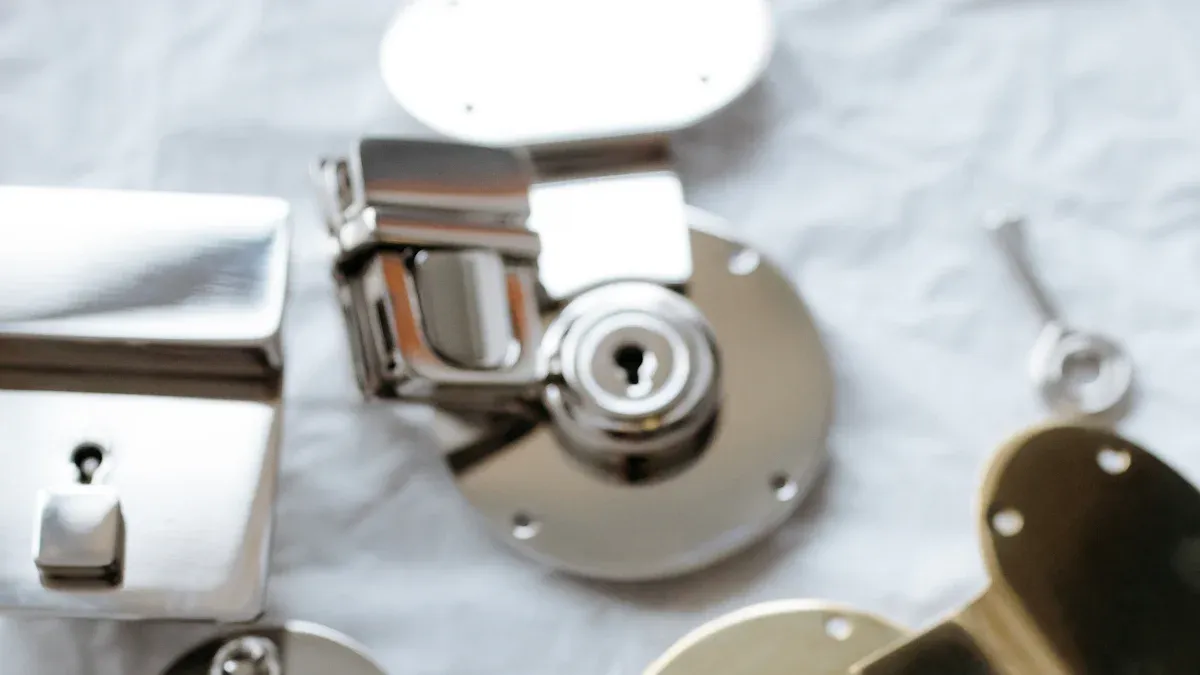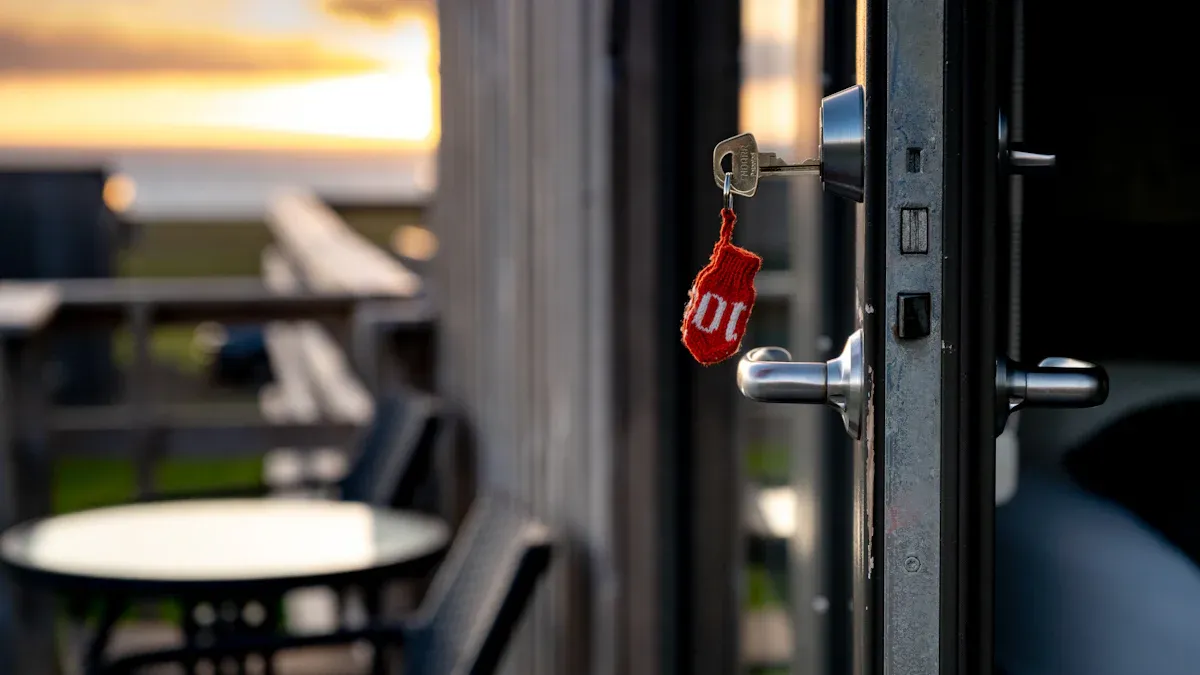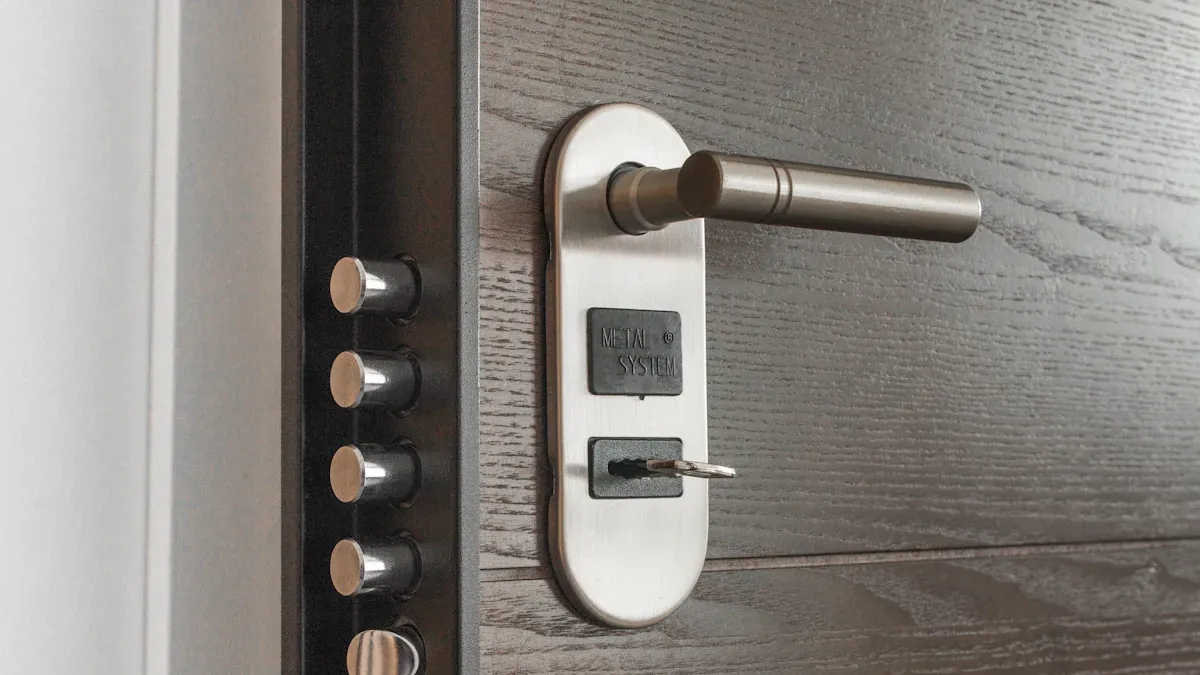
Aluminum Accessories Sliding Door And Window Latch Lock Crescent Lock Sliding Window Lock With Keys do not guarantee theft-proof security. Homeowners often find that these locks offer basic protection. Many experts caution against relying solely on an Aluminum Accessories Sliding Door lock for preventing unauthorized entry.
Key Takeaways
- Aluminum crescent locks offer basic protection but cannot fully prevent theft on their own.
- Proper installation and regular maintenance are essential to keep these locks effective.
- Combining crescent locks with other security measures greatly improves home safety.
What Does ‘Theft-Proof’ Mean for Aluminum Accessories Sliding Door And Window Latch Lock Crescent Lock Sliding Window Lock With Keys?
Defining Theft-Proof in Home Security
The term “theft-proof” often appears in marketing for home security products. In reality, no lock can guarantee absolute protection against a determined intruder. Security experts define “theft-proof” as a lock’s ability to deter or delay unauthorized entry long enough for occupants to respond or for help to arrive. For Aluminum Accessories Sliding Door And Window Latch Lock Crescent Lock Sliding Window Lock With Keys, the label “theft-proof” suggests a higher level of resistance to common break-in attempts. However, this does not mean the lock is invulnerable. Most locks serve as part of a broader security system, not as a standalone solution.
Note: Homeowners should view “theft-proof” claims with caution. A lock may slow down an intruder, but it rarely stops one entirely.
Criteria for Evaluating Lock Security
Security professionals use several criteria to assess the effectiveness of a lock:
- Material Strength: The lock should use durable metals that resist cutting, prying, or bending.
- Locking Mechanism: A complex mechanism makes picking or bypassing more difficult.
- Tamper Resistance: The design should minimize exposed screws or weak points.
- Ease of Use: Reliable operation ensures the lock is always engaged when needed.
- Compatibility: The lock must fit securely on the intended door or window frame.
A table below summarizes these criteria:
| Criteria | Importance in Security |
|---|---|
| Material Strength | Prevents physical attacks |
| Locking Mechanism | Stops picking/bumping |
| Tamper Resistance | Reduces vulnerability |
| Ease of Use | Ensures consistent use |
| Compatibility | Maintains secure fit |
Security Features of Aluminum Accessories Sliding Door And Window Latch Lock Crescent Lock Sliding Window Lock With Keys

Construction and Material Strength
Manufacturers of these locks focus on quality assurance throughout the production process. They source raw materials from certified suppliers and perform regular inspections to maintain consistent standards. The company offers a 3-year warranty and provides after-sale services such as technical support and onsite assistance. Recognized certifications like ISO9001, CE, and TUV support their commitment to quality management. Customers can also request independent inspections through organizations like SGS or TUV, especially for large orders. While these practices suggest a strong construction, specific materials testing reports or durability statistics are not available. This means buyers must rely on the company’s reputation and certification rather than direct evidence of strength.
Locking Mechanism and Key Operation
The locking mechanism in these crescent locks uses a rotating latch that secures the window or door in place. The key-operated design adds an extra layer of security by requiring a physical key to unlock the device. This feature helps prevent accidental unlocking and restricts access to authorized users. The mechanism operates smoothly, allowing homeowners to engage or disengage the lock with minimal effort. A well-designed key system also reduces the risk of lock picking or bumping, which are common methods used by intruders.
Resistance to Forced Entry and Tampering
These locks provide basic resistance to forced entry. The metal construction can withstand some prying or pushing, but determined intruders may still find ways to bypass the lock. The design minimizes exposed screws and weak points, making tampering more difficult. However, the overall security depends on the installation quality and the strength of the surrounding frame. Homeowners should not assume that the lock alone will stop all break-in attempts.
Tip: Combine these locks with additional security measures, such as security bars or alarms, to improve overall protection.
Real-World Security Performance of Crescent Lock Sliding Window Lock With Keys
Common Break-In Methods for Sliding Doors and Windows
Burglars often target sliding doors and windows because these entry points can be easier to bypass than traditional doors. Studies and security incident reports show several recurring tactics:
- Many intruders simply exploit open or unlocked sliding doors and windows.
- Weak or poorly installed locks allow burglars to force entry with minimal effort.
- Some criminals lift sliding doors off their tracks or use prying tools to bypass the lock.
- Surveys of burglary victims reveal that a significant number of break-ins occur through unsecured or easily defeated locks.
- Research highlights that burglars tend to avoid homes with visible, high-quality locks and additional security measures.
- Experts emphasize that partial security, such as locking only some windows or doors, leaves homes vulnerable. Burglars often search for the weakest point.
- Cross-national studies confirm that leaving sliding windows or doors open increases the risk of burglary.
Security professionals recommend using multiple security devices, such as channel locks, pin locks, and slide bolts, to strengthen sliding doors and windows.
How These Locks Perform Against Attacks
Physical penetration testing teams use a variety of methods to evaluate the durability of locks under attack. These teams simulate real-world break-in scenarios to assess how well locks like the Crescent Lock Sliding Window Lock With Keys withstand force and manipulation. The process includes:
- Defining the scope and objectives, focusing on physical security assets such as locks.
- Gathering information about the installation and surrounding infrastructure.
- Simulating attacks using tools for prying, lockpicking, and bypassing.
- Testing the lock’s resistance to being lifted, forced, or manipulated with common burglary tools.
Red Team and Black Box testing approaches provide unbiased assessments by simulating attackers with varying levels of information. Testers often use lockpicking and impressioning tools to bypass locks without triggering alarms. These tests reveal that while the Crescent Lock Sliding Window Lock With Keys can resist basic attacks, determined intruders with the right tools may still overcome them. The lock’s performance depends heavily on installation quality and the strength of the door or window frame.
Tip: Regularly inspect and maintain locks to ensure they function as intended. Even the best lock loses effectiveness if installed incorrectly or left in disrepair.
Reported Vulnerabilities and User Experiences
User feedback and investigative studies highlight several vulnerabilities associated with Crescent Lock Sliding Window Lock With Keys. Many homeowners report that these locks provide peace of mind for daily use but express concerns about their ability to withstand determined attacks. Common issues include:
- Locks that loosen over time, especially if installed on older or weaker frames.
- Keys that become difficult to turn, leading to inconsistent locking.
- Some users experience false confidence, believing the lock alone offers complete protection.
- Reports indicate that burglars often bypass these locks by targeting the frame or using prying tools.
A table below summarizes user-reported strengths and weaknesses:
| Strengths | Weaknesses |
|---|---|
| Easy to use | Vulnerable to prying |
| Keyed access adds control | Can loosen with repeated use |
| Deters casual intruders | May not withstand strong force |
| Affordable and widely available | Relies on frame strength |
Note: Combining these locks with additional security measures, such as security bars or alarms, significantly improves overall protection.
Comparing Aluminum Accessories Crescent Locks With Other Sliding Window and Door Locks

Standard Latch Locks vs. Crescent Locks
Standard latch locks use a simple hook or lever to secure sliding doors and windows. These locks often provide basic protection but can fail under force or manipulation. Crescent locks, on the other hand, use a rotating latch that fits snugly into a catch plate. This design offers a tighter seal and reduces the risk of accidental disengagement. Many homeowners prefer crescent locks for their ease of use and improved resistance to casual tampering. However, both types rely heavily on the strength of the window or door frame.
Keyed vs. Keyless Options
Keyed locks require a physical key for operation. They offer familiarity and straightforward control. Lost keys, however, can lead to costly replacements and potential security risks. Keyless options, such as keypads, smart locks, or biometric systems, provide greater convenience and scalability. These systems allow for remote management and flexible access control. Experts note that keyless solutions introduce new vulnerabilities, including cybersecurity threats and dependence on power or network connectivity. The table below summarizes the reliability and security considerations for various access methods:
| Access Method | Reliability & Convenience | Security Considerations & Vulnerabilities |
|---|---|---|
| Key Cards and FOBs | Simple, reliable, easy to use, minimal maintenance | Lost, stolen, or copied credentials; no remote management; replacement costs; power loss disables access |
| Keypads and PIN Readers | Convenient, easy to retrofit, no physical credential needed | PINs can be shared or stolen; require on-site troubleshooting |
| Keyless Smart Locks | Remote monitoring, flexible programming, fast response | Network/power outages; cybersecurity threats; higher installation costs |
| Biometrics | No lost keys/cards, strong security, central management | High upfront cost; possible false rejections; limited remote authorization |
| Smartphone Mobile Credentials | Cloud-managed, secure, scalable onboarding/offboarding | Dependent on device security; lost/stolen phones block access; battery/network issues |
Experts recommend hybrid models that combine keyed and keyless features for balanced security and reliability.
High-Security Alternatives
High-security locks for sliding doors and windows include double-bolt locks, security bars, and electronic access systems. These products use reinforced materials and advanced mechanisms to resist forced entry. Some models integrate alarms or sensors for real-time alerts. Security professionals suggest upgrading to these alternatives in areas with higher crime rates or when protecting valuable assets. Homeowners should evaluate their specific needs and consider combining multiple security measures for optimal protection.
Practical Security Recommendations for Sliding Windows and Doors
Tips for Maximizing Lock Security
Homeowners can take several steps to improve the effectiveness of sliding window and door locks. Regular maintenance ensures that locks function properly and remain secure. Proper installation is critical; a poorly installed lock can fail even if it uses strong materials. Security experts recommend checking for loose screws, worn parts, or misaligned components. Upgrading to secondary locking mechanisms, such as pin locks or thumb turn locks, can prevent common bypass methods. Reinforcing the glass with security film or polycarbonate panels helps resist shattering and forced entry.
Tip: Schedule periodic inspections to catch vulnerabilities before they become security risks.
Combining Crescent Locks With Additional Measures
Layered security provides the best protection for sliding doors and windows. Physical barriers, such as security bars or charley bars, block forced opening attempts. Window sensors and glass break detectors, when connected to a home security system, alert occupants to unauthorized entry. Motion-activated lights near entry points deter intruders by increasing visibility. Curtains or decorative films can obscure valuables from view. Smart home technology, including remote monitoring and instant alerts, adds another layer of defense.
- Install secondary locks at the top or bottom of the door.
- Use a security bar in the track to prevent sliding.
- Integrate visible security cameras for deterrence and monitoring.
When to Upgrade to Higher-Security Solutions
Upgrading to advanced security solutions becomes necessary when existing hardware shows signs of wear, fails to meet current security needs, or after a security incident. Research shows that sliding doors are vulnerable to being lifted out of tracks, glass breakage, and simple lock bypassing. Installing tracker blocks, reinforcing glass, and adding deadbolts or floor-mounted locks significantly increase resistance to forced entry. Homeowners should consider upgrades when living in high-risk areas or when current locks do not provide peace of mind.
| Upgrade Trigger | Recommended Action |
|---|---|
| Outdated or basic hardware | Install modern, durable locks |
| Compromised security | Add secondary steel locks and reinforcement |
| Heightened risk of intrusion | Integrate alarms and smart monitoring |
Aluminum Accessories Sliding Door And Window Latch Lock Crescent Lock Sliding Window Lock With Keys provide basic theft deterrence but do not offer complete protection. Homeowners should adopt a layered security approach, combining multiple safeguards. This strategy, supported by multilayered security models, reduces risk and strengthens overall home defense.
FAQ
Are crescent locks suitable for all types of sliding windows and doors?
Most crescent locks fit standard aluminum sliding windows and doors. Some models may not suit thicker frames or non-standard designs. Always check compatibility before purchase.
Can a homeowner install a crescent lock without professional help?
Many crescent locks come with installation instructions. Homeowners with basic tools and skills can usually install them. For best results, follow the manufacturer’s guidelines.
Do crescent locks require regular maintenance?
Yes. Regularly check for loose screws, worn parts, or misalignment. Proper maintenance ensures the lock works effectively and extends its lifespan.
Post time: Jun-29-2025
